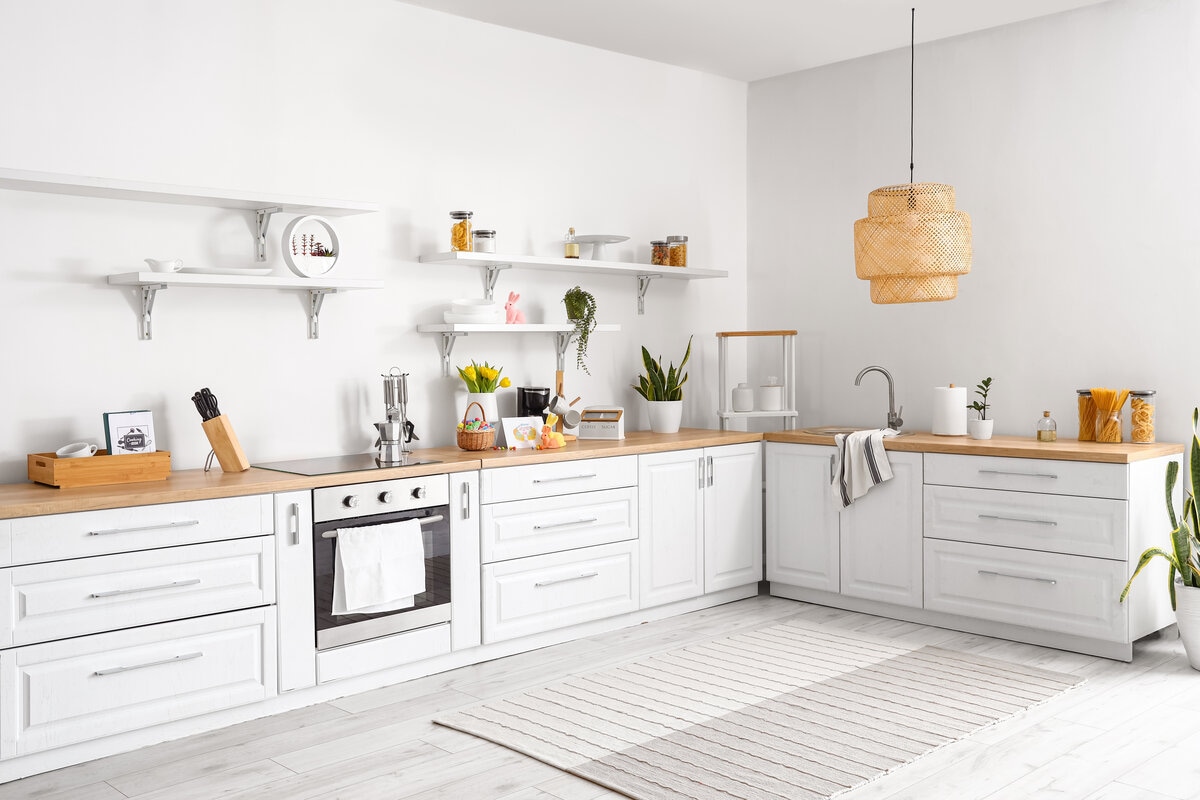Butcher block countertops have captivated homeowners for decades with their timeless charm and natural beauty. But beyond their aesthetics, these countertops offer surprising functionality and durability, perfect for busy kitchens. If you’re considering the warmth and character of butcher block for your kitchen remodel, you’ve come to the right place! This butcher block countertop guide will equip you with everything you need to know about butcher block countertops. Our award-winning kitchen designer will delve into the different types of wood, explore design considerations, and answer all your burning questions about maintenance and upkeep. So, grab a cup of coffee, settle in, and get ready to transform your kitchen into a culinary haven with the rich appeal of butcher block countertops!
What Are Butcher Block Countertops Made Of?
Butcher block countertops can be made of almost any kind of wood. Usually, they’re made of thick layers of natural wood or wood veneer that are glued together in slabs. The wood can come from almost any kind of tree, but the most popular choices include:
- Hardwoods: Maple, walnut, and oak are popular choices for butcher block counters, mainly due to their durability. Hard maple is stronger than soft maple, while oak is resistant to moisture. Walnut also comes in a range of colors, from light brown to dark chocolate.
- Other Woods: Cherry and red oak may also be used to make butcher block counters, adding a darker brown or hints of red to a kitchen. Acacia and bamboo are also popular choices due to their toughness and affordability.
Different Styles of Butcher Block Countertops
Butcher block countertops come in various styles, each of which is uniquely made and offers a particular aesthetic:
- Edge Grain: This classic style features long, straight wood cuts glued together to form a smooth, linear surface. The edge grain displays the continuous growth rings of the tree, creating a clean and elegant look.
- Blended Grain: Blended grain countertops incorporate wood rails of varying lengths for a more rustic appeal. These rails are finger-jointed, laminated, and glued side-by-side to create a distinctive pattern.
- End Grain: This style offers a visual feast! Imagine a checkerboard pattern made entirely of wood. End grain countertops achieve this stunning effect by stacking edge grain boards vertically and gluing them together. The exposed ends of the grain result in a unique and highly durable surface.
When Is Butcher Block Countertop Outdated?
Never. Butcher block countertops are not and likely will never be outdated. They can work in many kitchen styles, including modern, country cottage, and farmhouse. They can also be paired with cabinets of all styles and colors. Countertops made of butcher block also tend to be more affordable and durable than other countertop options. They can also add a unique warmth to the heart of the home. The bottom line is that butcher block isn’t a temporary fad but rather a timeless option for your home.
Can You Stain a Butcher Block Counter?
If you opt for butcher block countertops but want the option to change up your look in the future without replacing anything, you can always stain them. You can stain and seal butcher block counters to either change up the look, help with maintenance, and prevent water stains.
Pros and Cons of Butcher Block Countertops: Are They for You?
There are pros and cons to all types of countertops that you should consider before deciding what you want to incorporate in your kitchen interior design or remodel. Below are the advantages and disadvantages of butcher block countertops that can help you choose the best option for your taste and lifestyle.
What Is the Downside of Using Butcher Block Countertops?
- Regular Maintenance: These types of countertops require regular maintenance, such as sealing and cleaning, to prevent water stains and scratches. It’s also recommended to avoid cutting directly on the surface with a knife, as this could also cause wear and tear.
- Not Heat Resistant: If hot pots and pans are placed directly on it, you risk leaving burn marks on the butcher block.
- Water Damage Risks: Water can stain butcher block or create water rings if the surface is not treated or sealed properly. Certain liquids and foods – such as coffee, wine, and heavy oils – can also stain or break down the seal over time. For this reason, regular maintenance is recommended.
- Porous Surface: As with any wood surface, butcher block can expand and contract with temperature and humidity, which may fluctuate in a kitchen.
- Risk of Drying Out: As is the case with any wood material, butcher block counters can dry out if you do not apply food-grade mineral oil routinely.
What Is the Upside of Using a Butcher Block Kitchen Counter?
Some pros of using butcher block counters in a kitchen include:
- Versatility and Beauty: While popular choices, butcher block countertops can go beyond traditional woods like maple or oak. Expand your design horizons with options like bamboo, teak, or even exotic choices like tigerwood, zebrawood, or wenge. Plus, the edge grain, end grain, and blended styles offer further customization to match your taste.
- Budget Considerations: Butcher block countertops fall into the sweet spot between affordability and luxury. While more expensive than laminate, they cost considerably less than natural stone countertops.
- Built to Last: With proper care, butcher block countertops can rival the lifespan of granite, lasting around 20 years. This easily outlasts laminate countertops, making them a wise investment for your kitchen.
- Simple Cleaning: Maintaining the beauty of your butcher block doesn’t require harsh chemicals. Applying a simple solution of warm water and dish soap with a sponge does the job most of the time. For disinfection, vinegar is your friend. And if you encounter a stubborn stain, rubbing half a lemon with salt over the spot can work wonders.
- Renewing Your Countertop: Scratches or nicks on butcher block are easily addressed with sanding and refinishing. Simply sand the affected area with fine-grit sandpaper, like 220 grit, and re-oil the surface with food-safe mineral oil. This keeps your butcher block looking fresh for years to come.
- Sanitary: Some types of wood used for butcher blocks have natural antibacterial properties, making them an excellent countertop choice for kitchens.
No matter what you decide, Karin Ross Designs is here to make your vision come to life. Our kitchen and bathroom remodeling company in Kansas City offers a wide range of countertop options you can choose from when redesigning your kitchen. If you’re thinking of revamping your kitchen, check out our past kitchen designs now!
How to Care for a Butcher Block Counter
Below are both cleaning and maintenance tips for butcher block counters to ensure the heart of your home always maintains its beauty!
How to Clean Butcher Block Countertops
Gather Your Supplies:
- Warm water
- Dish soap
- Baking soda (optional)
- White vinegar (optional)
- Sponge or dishcloth
- Microfiber cloth
- Food-safe mineral oil (for occasional conditioning)
Cleaning Steps:
- Clear the countertop.
- Fill a bowl with warm water and add a few drops of dish soap. Dip your sponge or dishcloth into the bowl and wring it out so it’s not dripping. Wipe down the entire surface of the butcher block, giving extra attention to any spills or messes.
- Rinse the cleaning solution off the countertop with clean water. Use a fresh microfiber cloth to thoroughly dry the surface. Be sure to remove all excess moisture to prevent water stains.
For Tough Stains or Disinfection:
- Baking Soda Paste: For stubborn stains, create a paste using baking soda and a little water. Apply the paste directly to the stain and gently scrub with a damp cloth. Rinse the area clean and dry thoroughly.
- White Vinegar Solution: As previously mentioned, white vinegar is a natural disinfectant. Dilute white vinegar with an equal amount of water, dip a clean cloth into the solution, and wipe down the countertop. Rinse the surface with clean water and dry completely.
Note: Avoid using harsh chemicals, bleach, or abrasive cleaners on your butcher block. These can damage the wood and dull its natural beauty.
Butcher Block Countertop Maintenance Tips
- Clean Daily: A great way to maintain the cleanliness and appearance of butcher block is to clean daily with a damp cloth or sponge and warm water with some dish soap. This will help to remove crumbs, spills, and debris from the surface. You can also sanitize the surface with a water and vinegar solution.
- Avoid Damaging the Surface: While the chop you hear when cutting directly onto the butcher block can be satisfying, it can also damage the surface. Instead, we recommend using a cutting board. Also, avoid placing wet dishes or towels on the wood, and avoid using harsh chemicals for cleaning.
- Reseal With Food-Safe Mineral Oil: To maintain the luster and protect the woo of your butcher block countertops, you can periodically apply a thin coat of food-safe mineral oil. Apply a light layer of oil to the dry surface with a clean cloth, buffing it gently to an even sheen. Let the oil absorb for a few hours before using the countertop again. This oil will prevent unwanted moisture from getting into the wood and will keep important moisture in the wood.
By following these simple steps, you can keep your butcher block countertops clean, protected, and looking their best for years to come.
The Beauty of Butcher Block: A Timeless Addition to Your Kitchen
Butcher block countertops offer a captivating blend of warmth, functionality, and natural beauty. With proper care and cleaning, they can become the heart of your kitchen for years to come. We hope this guide helps you to confidently clean and maintain your butcher block surfaces.
Are You Ready to Craft Your Dream Kitchen?
If you’re considering incorporating butcher block countertops into your kitchen remodel, or if you’d love a complete kitchen makeover, Karin Ross Designs is here to help! Our Kansas City interior designer can guide you through every step of the process, from selecting the perfect butcher block style to creating a cohesive and functional kitchen layout.
We specialize in transforming both bathrooms and kitchens into beautiful and inviting spaces that reflect your unique style and personality. Contact Karin Ross Designs today and let’s discuss your vision for your dream kitchen!










